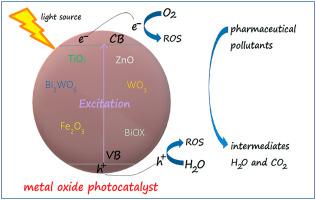Materials Today Chemistry ( IF 6.7 ) Pub Date : 2021-01-06 , DOI: 10.1016/j.mtchem.2020.100380 T. Velempini , E. Prabakaran , K. Pillay

|
In recent years, metal oxide semiconductors have been explored as photocatalysts for the degradation of organic contaminants in water/wastewater. The uniqueness of these oxide materials is in their ability to harness energy in the UV/Vis range, their relative ease of synthesis, low cost, and their general high surface ratio to mass, etc. Thus, these materials have consequently drawn much profound interest in environment applications, particularly pharmaceutical drugs for photocatalytic degradation. Furthermore, the non-toxic nature of most metal oxide semiconductors means they are convenient for water treatment works, resulting in safe drinking water for humans and safe environments for aquatic mammals. Pharmaceuticals are emerging pollutants that are increasingly being found in water systems. They have been detrimental to the human and animal health. In this article, pharmaceutical drugs abatement from water via photocatalysis process using oxide-based advanced metals such as TiO2, ZnO, Fe2O3,WO3, and Bi2WO6 is discussed. Degradation of various drugs at laboratory scale have been assessed and examples cited. Various approaches to metal oxides modifications and synthesis methods to improve degradation efficiency have also been discussed. Effects of experimental/operational parameters in the degradation process have been compiled and compared. Finally, a short preview of degradation of pharmaceuticals pilot scales is also highlighted.
中文翻译:

使用金属氧化物光催化降解水中药物污染物的最新进展-综述
近年来,已经开发了金属氧化物半导体作为光催化剂,用于降解水/废水中的有机污染物。这些氧化物材料的独特之处在于它们能够利用UV / Vis范围内的能量,它们的相对易合成性,低成本以及它们通常具有高的表面质量比等。因此,这些材料引起了人们极大的兴趣在环境应用中,特别是用于光催化降解的药物。此外,大多数金属氧化物半导体的无毒性质意味着它们便于水处理工作,从而为人类提供了安全的饮用水,为水生哺乳动物提供了安全的环境。药物是在水系统中越来越多地发现的新兴污染物。它们已经有害于人类和动物健康。在本文中,使用基于氧化物的高级金属(例如TiO)通过光催化过程从水中消除药物参照图2,讨论ZnO,Fe 2 O 3,WO 3和Bi 2 WO 6。已经评估了各种药物在实验室规模上的降解,并列举了一些实例。还讨论了各种金属氧化物改性方法和合成方法以提高降解效率。实验/操作参数对降解过程的影响已被汇编和比较。最后,还着重介绍了药物中试规模下降的简短预告。











































 京公网安备 11010802027423号
京公网安备 11010802027423号